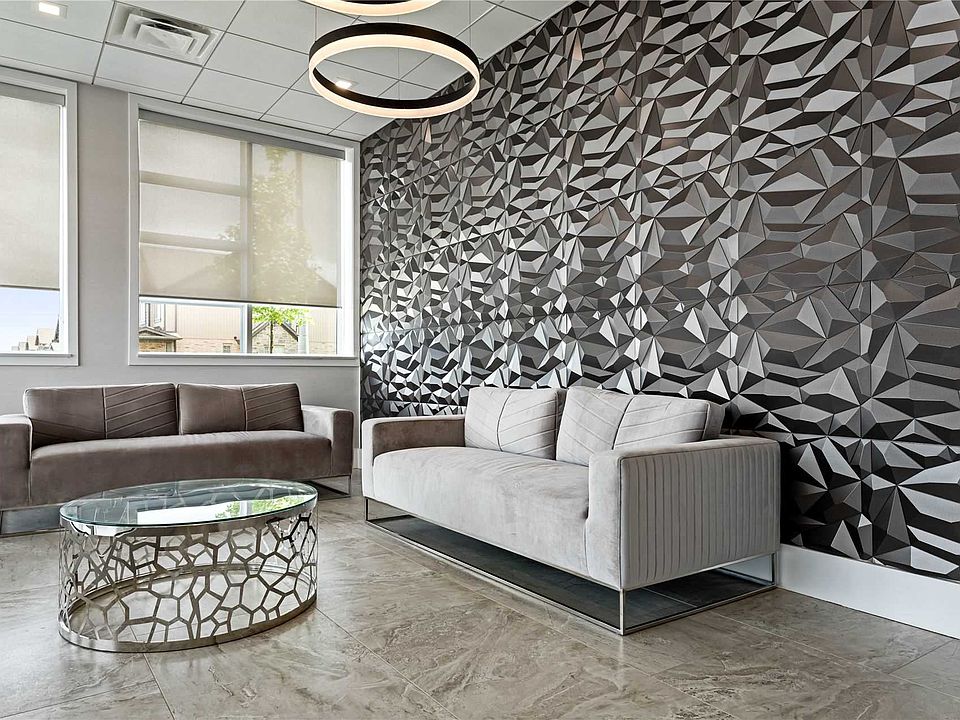In the realm of interior design, 3D wall panels have emerged as a versatile and stylish solution for adding depth, texture, and visual interest to spaces. These decorative panels come in a variety of materials, each offering its own unique characteristics and aesthetic appeal. Let’s delve into the world of popular 3D wall panels materials and discover how they can transform your walls into stunning works of art.
- PVC (Polyvinyl Chloride): PVC is one of the most popular materials used for 3D wall panels due to its affordability, versatility, and durability. These panels are lightweight, easy to install, and resistant to moisture, making them suitable for a variety of interior environments, including bathrooms, kitchens, and basements. PVC panels come in a range of designs and finishes, from sleek and modern to textured and embossed, allowing for endless customization options to suit different design preferences and aesthetics.

- MDF (Medium-Density Fiberboard): MDF is another common material used for 3D wall panels, valued for its affordability and versatility. These panels are made from wood fibers bonded together with adhesive, resulting in a dense and uniform surface that is easy to paint, stain, or finish. MDF panels can be machined with intricate designs and patterns, offering endless possibilities for creating custom wall treatments that add dimension and character to any space. While MDF panels are not suitable for high-moisture environments, they are an excellent choice for accent walls, feature panels, and decorative installations in residential and commercial settings.
- Gypsum (Plaster): Gypsum or plaster 3D wall panels are prized for their luxurious appearance and tactile texture. These panels are crafted from natural gypsum or synthetic plaster materials, and molded into intricate patterns and designs that create stunning visual effects on walls. Gypsum panels can be left unfinished for a raw and organic look, or they can be painted, glazed, or adorned with metallic leaf finishes to enhance their aesthetic appeal. While gypsum panels require professional installation and are more susceptible to damage from moisture and impact compared to other materials, they offer unparalleled elegance and sophistication that can elevate any interior space.
- Wood: Wood 3D wall panels bring warmth, texture, and natural beauty to interior settings, making them a popular choice for adding rustic charm or contemporary flair to walls. These panels are crafted from various wood species, including pine, oak, cedar, and teak, each offering its own unique grain patterns and colors. Wood panels can be installed in their natural state for a rustic look, stained or painted to match existing decor, or treated with finishes like whitewash or weathering for a distressed or aged appearance. While wood panels may require more maintenance and care compared to other materials, their timeless appeal and versatility make them a favorite among homeowners, designers, and architects alike.
- Metal: Metal 3D wall panels lend a sleek, modern, and industrial aesthetic to interior spaces, making them a popular choice for contemporary design schemes. These panels are typically crafted from materials like aluminum, stainless steel, or copper, which are cut, stamped, or laser-etched to create intricate patterns and textures. Metal panels can be left unfinished for a minimalist look, polished to a high sheen for a reflective effect, or treated with patinas and coatings to add depth and character. While metal panels may be more expensive and challenging to install compared to other materials, they offer durability, longevity, and a striking visual impact that can transform any wall into a statement piece.
- Leather: Leather 3D wall panels offer a luxurious and sophisticated aesthetic that adds richness and elegance to interior spaces. These panels are crafted from genuine or faux leather materials, which are embossed, stitched, or quilted to create intricate patterns and textures. Leather panels come in a variety of colors, finishes, and grain patterns, allowing for customization to suit different design styles and preferences. While leather panels may require special care and maintenance to preserve their appearance and texture, they provide a timeless and opulent look that adds depth and character to any room, making them a popular choice for high-end residential and commercial settings.
- Concrete: Concrete 3D wall panels bring an urban, industrial, and contemporary vibe to interior spaces, making them a popular choice for modern design schemes. These panels are crafted from precast concrete or cementitious materials, which are poured, molded, or formed into various shapes, textures, and patterns. Concrete panels can be left unfinished for a raw and minimalist look, or they can be polished, stained, or sealed to enhance their aesthetic appeal and durability. While concrete panels may be heavier and more challenging to install compared to other materials, they offer durability, fire resistance, and a unique tactile quality that adds character and personality to walls, making them a popular choice for residential lofts, commercial offices, and industrial-inspired interiors.
In conclusion, popular 3D wall panels materials offer a versatile and stylish solution for enhancing interior spaces with texture, dimension, and visual interest. Whether crafted from PVC, MDF, gypsum, wood, or metal, each material brings its own unique characteristics and aesthetic appeal to wall treatments, allowing for endless customization options to suit different design preferences and environments. By exploring the world of popular 3D wall panel materials, homeowners, designers, and architects can unleash their creativity and transform ordinary walls into extraordinary works of art.



